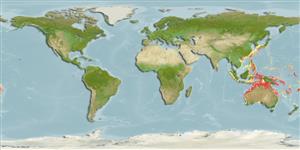Actinopterygii (ray-finned fishes) >
Pleuronectiformes (Flatfishes) >
Cynoglossidae (Tonguefishes) > Cynoglossinae
Etymology: Paraplagusia: Greek, para = the side of + Greek, plagos, plagios = oblique; longirostris: longirostris from the Latin meaning 'long snout'.
Environment / Climate / Range
Ecology
Marine; demersal; depth range 12 - 86 m (Ref. 9224). Tropical, preferred ?
Indo-West Pacific: northern Australia and southern coast of Papua New Guinea.
Size / Weight / Age
Maturity: Lm ? range ? - ? cm
Max length : 27.6 cm SL male/unsexed; (Ref. 9224)
Short description
Morphology | Morphometrics
Dorsal
soft rays
(total): 133-143;
Anal
soft rays: 102 - 112. Caudal vertebrae 49-55; mid-lateral line scales 115-125. Differs from all other species in the genus Paraplagusia by the non-overlapping high counts for the dorsal and anal fin rays, caudal vertebrae and mid-lateral line scales.
Life cycle and mating behavior
Maturity | Reproduction | Spawning | Eggs | Fecundity | Larvae
Chapleau, F., C.B. Renaud and P.J. Kailola, 1991. Paraplagusia longirostris, a new flatfish (Cynoglosidae) from Australia and Papua New Guinea. Jap. J. Ichthyol. 38(3):239-244. (Ref. 9224)
IUCN Red List Status (Ref. 115185)
CITES (Ref. 94142)
Not Evaluated
Threat to humans
Harmless
Human uses
Fisheries: of no interest
More information
Common namesSynonymsMetabolismPredatorsEcotoxicologyReproductionMaturitySpawningFecundityEggsEgg development
Age/SizeGrowthLength-weightLength-lengthLength-frequenciesMorphometricsMorphologyLarvaeLarval dynamicsRecruitmentAbundance
ReferencesAquacultureAquaculture profileStrainsGeneticsAllele frequenciesHeritabilityDiseasesProcessingMass conversion
Tools
Special reports
Download XML
Internet sources
